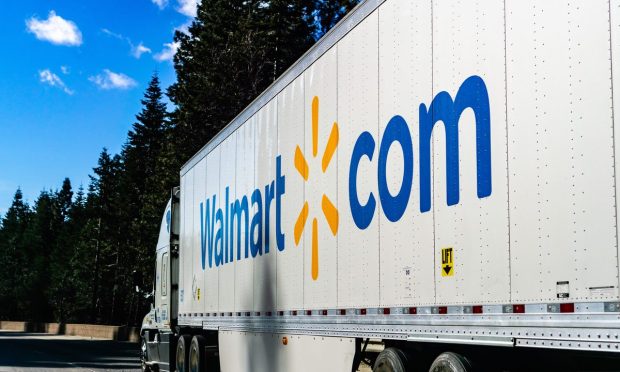AMZN vs WMT Weekly: Logistics Take Center Stage Ahead of Bring-It-to-Me Holidays

Walmart’s last-mile delivery network got a stamp of approval this week from rival retailer The Home Depot, which signed on be the first retail client to use the box store chain’s white-label delivery-as-a-service platform, called Walmart GoLocal.
Read: Walmart GoLocal Signs Home Depot as First Retail Client
Beyond just its impacts on Walmart, though, the deal shows how serious big-name retailers are about avoiding last year’s last-mile snafus, which caused more than 1 million holiday orders to miss Christmas.
Amazon also provides logistics capabilities to competitors through its Multi-Channel Fulfillment unit, offering packing and delivery services to eCommerce merchants on Shopify, Etsy and other marketplaces. Last month, Amazon expanded its Same-Day Delivery service to three new metro areas — Atlanta, Miami and Minneapolis — and expanded the offering in Chicago. The eCommerce giant offers same-day delivery in a total of 15 cities at present.
These offerings have legs beyond the holiday shopping season, though. Home delivery has become so ubiquitous that U.S. consumers see it as a necessity, with most having built up the habit while holed up at the height of the pandemic. PYMNTS data show that 91% of U.S. consumers have made at least one purchase on Amazon in the past year, and 70% have shopped on another digital marketplace.
New Positions for New Leaders
Walmart also spent the week rearranging part of its U.S. C-suite, promoting Chris Nicholas from chief financial officer to the newly created position of chief operating officer (COO) of Walmart U.S. and hiring Instacart’s Seth Dallaire as chief revenue officer, also a new position. Steve Schmitt, executive vice president and chief financial officer of Walmart U.S. omnichannel, will take over Nicholas’s previous position.
The COO position combines store operations and supply chain responsibilities, while the chief revenue officer will be responsible for Walmart’s media business, Walmart Connect, Walmart+, data monetization and business partnerships.
Walmart U.S. President and CEO John Furner said in a company memo announcing the new roles that the moves are meant to accelerate the retail giant’s omnichannel strategy.
“Ensuring our structure reinforces our strategy is imperative to our transformation to a more digital, customer-centric organization,” Furner said. “And it will ultimately power our flywheel by helping us win in primary destination and better monetization of our assets and capabilities.”
Walmart in its second quarter showed the strengths of its omnichannel platform, which gave it the ability to capture consumers’ dollars in-store as foot traffic picked up earlier this year and online as concerns about the delta variant increased. But the box store giant is increasingly looking to make its tools work for others, too, and permeate more of the retail ecosystem with services like GoLocal as well as the licensing of its technologies and digital capabilities through a collaboration with Adobe.
See: Walmart Bets On Delivery Network In Latest Expansion Of Third-Party Services
Getting Closer to Consumers
Meanwhile, Amazon is working to expand its physical presence, opening its first Amazon 4-Star store outside of the U.S. with a 3,500-square-foot location in the U.K. and gaining approval from two U.S. municipalities for potential new Amazon Fresh stores.
Amazon opened the first 4-Star store in New York City in 2018 and now has 32 locations across the U.S. The company’s rollout of Amazon Fresh and other grocery efforts, however, have proven to be somewhat erratic in the past 10 months, as PYMNTS has previously reported, with some moments that suggest impressive growth and others that show uncertainty about the trajectory of the grocery business.
Read more: Doors Open at First Amazon UK 4-Star Store Outside US
And: Amazon’s Grocery Footprint Grows with Amazon Fresh Expansion
While more stores will allow Amazon to reach the nearly 60% of shoppers who still are brick-and-mortar natives, the locations may also more importantly be a way of bringing last-mile logistics even closer to where customers live. The eCommerce giant is reportedly planning to open department store-style locations in San Francisco and Columbus, Ohio, that will largely be a hub for the company to sell T-shirts, jeans, and other items from its own labels and a mix of third-party sellers.
See: Technology Front and Center in Proposed Amazon Department Stores
Brian Walker, chief strategy officer at digital experience platform Bloomreach, told PYMNTS that he doesn’t see this as a change in Amazon’s strategy as a digital-first business but rather as an additive way to engage customers and gain further wallet share.
“Amazon is looking now to cement themselves as a consumer brand and bring their last-mile fulfillment ever closer to the shopper,” he said. “And of course they can do this while capitalizing on the very challenged big box retail real-estate market, for very cost efficient and flexible leases.”
